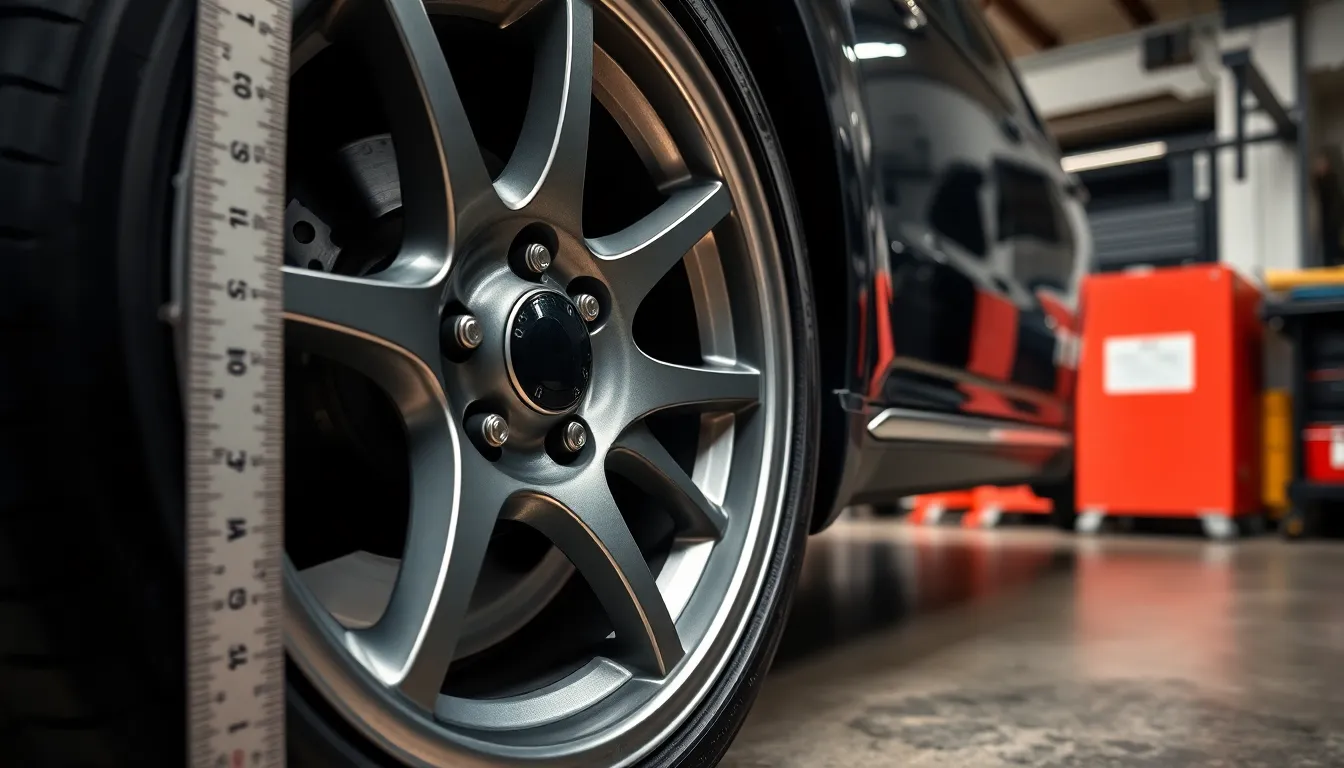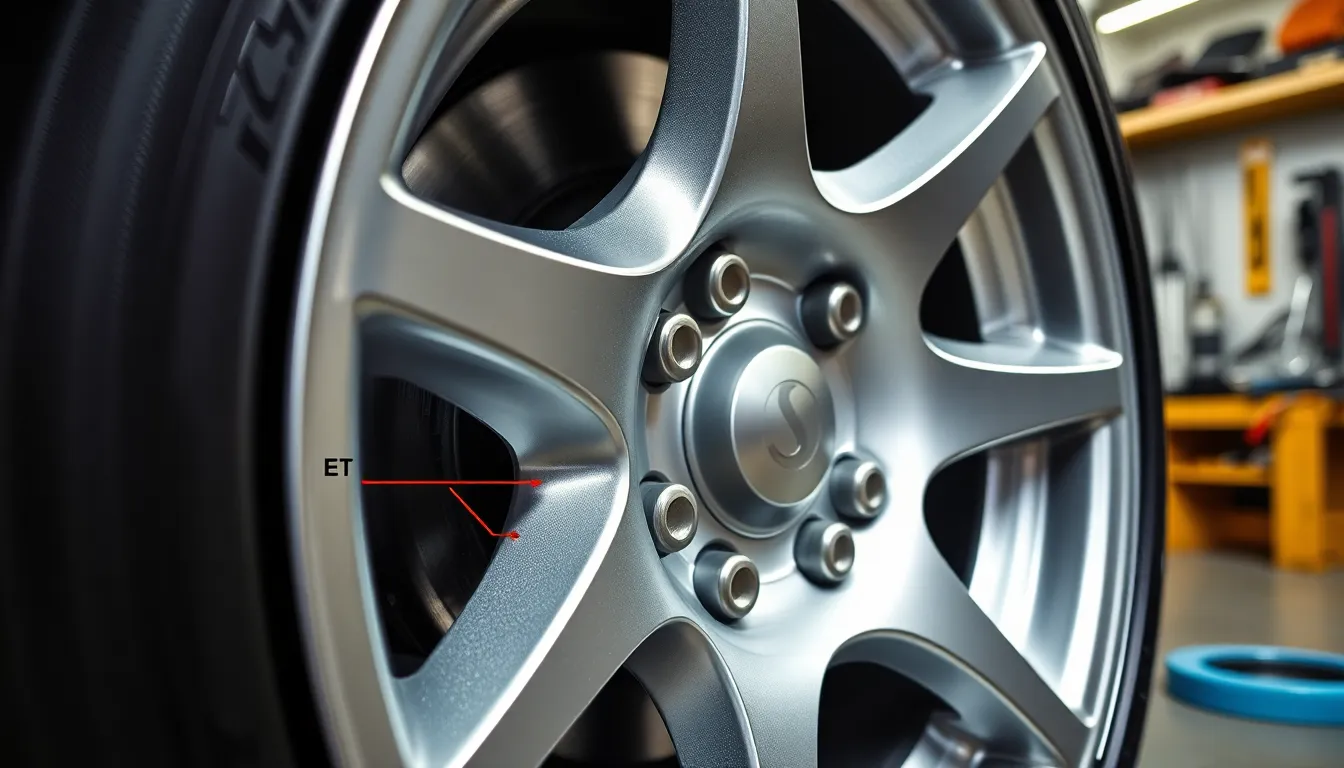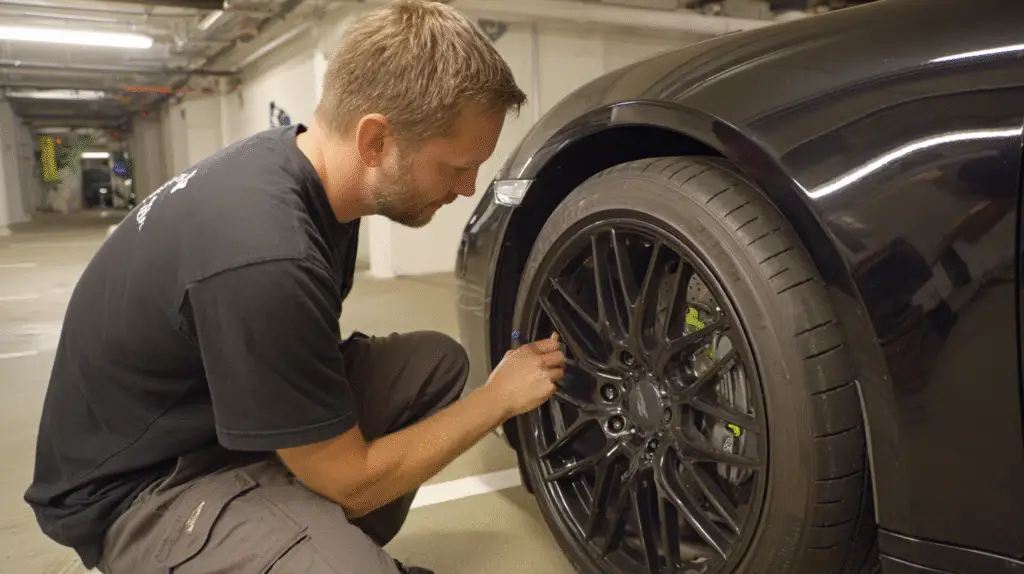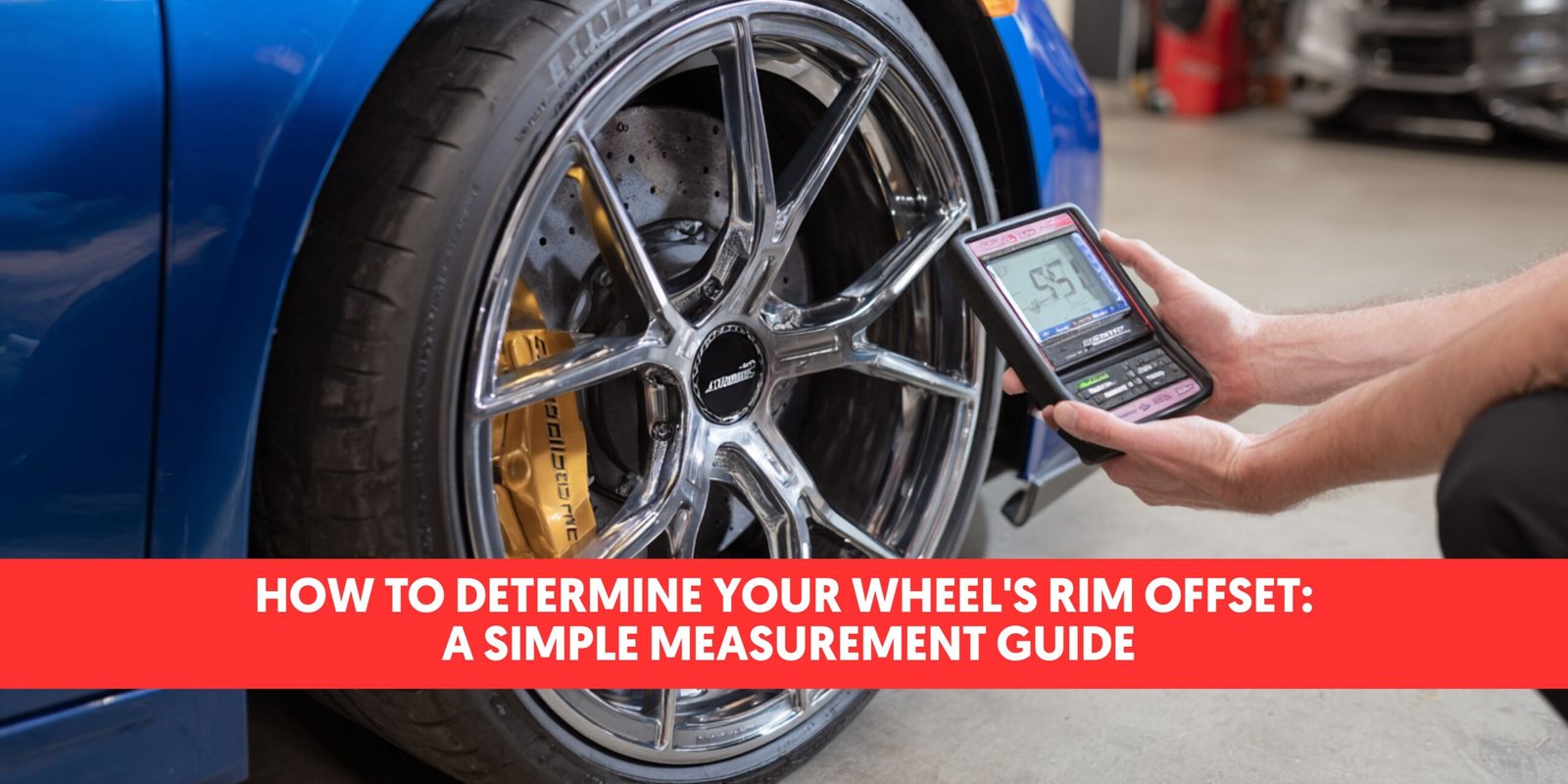Struggling to determine your rim offset? This critical measurement can make or break your vehicle’s performance, appearance, and safety. Knowing the right offset ensures your new wheels fit perfectly without rubbing against suspension components or protruding beyond fenders.
Understanding rim offset doesn’t have to be complicated. It’s simply the distance between your wheel’s mounting surface and its centerline, measured in millimeters. Whether you’re upgrading your wheels, replacing damaged rims, or just wanting to achieve that perfect stance, measuring offset correctly is essential. We’ll walk you through the straightforward process using common tools you likely already have at home.
What Is Rim Offset and Why Does It Matter
Rim offset represents the distance in millimeters between the wheel’s mounting surface and its centerline. This measurement determines how your wheels sit in relation to your vehicle’s body and suspension components. Positive offset means the mounting surface is toward the front or street side of the wheel, while negative offset places it toward the back or brake side.
The importance of correct rim offset can’t be overstated for several critical reasons. Improper offset affects handling by changing the scrub radius and steering geometry, potentially causing premature wear on steering components and bearings. Many drivers experience unpredictable steering behavior after installing wheels with incorrect offset measurements.
Performance enthusiasts particularly care about offset because it directly impacts a vehicle’s track width. Wheels with more negative offset effectively widen your stance, improving cornering stability at the expense of increased stress on suspension components. Track day regulars often experiment with offset to find the perfect balance between stability and component longevity.
Aesthetically, offset determines whether your wheels sit flush with the fender, poke out beyond the body line, or tuck underneath. The popular “flush” look requires precise offset calculations exact to your vehicle model. Street cars with perfectly matched offset measurements attract attention at car shows and gatherings.
Safety concerns arise when incorrect offset causes wheels to rub against brake calipers, suspension components, or the vehicle’s body. These clearance issues create dangerous driving conditions, including potential tire failure or compromised steering control. Emergency maneuvers become particularly hazardous with improperly fitted wheels due to unpredictable handling characteristics.
Understanding Rim Measurements: Offset vs. Backspacing

Rim measurements involve two critical specifications that determine how wheels fit on your vehicle: offset and backspacing. These measurements affect everything from handling characteristics to clearance issues with your vehicle’s suspension components.
Key Differences Between Offset and Backspacing
Offset refers to the distance in millimeters between the wheel’s mounting surface and its centerline. Backspacing measures the distance from the mounting surface to the inner edge of the wheel in inches. The primary distinction lies in their reference points—offset uses the wheel’s centerline while backspacing uses the inner edge as its reference point.
When measuring offset, you’re determining how far inward or outward the wheel sits relative to the hub, which directly impacts track width and suspension geometry. Positive offset positions the mounting surface closer to the street side, while negative offset places it closer to the brake side.
Backspacing provides a more intuitive measurement for visualizing wheel fitment inside the wheel well. Greater backspacing means more of the wheel tucks inside the vehicle, while less backspacing results in wheels that protrude outward.
Professional wheel installers often use both measurements when determining proper fitment. While offset is the standard specification used by manufacturers globally, backspacing remains popular in American aftermarket wheel applications.
Converting between these measurements requires knowing the wheel’s width. For a 9-inch wide wheel with 5 inches of backspacing, the calculation shows an offset of approximately +15mm, demonstrating how these measurements relate mathematically.
Many performance enthusiasts prefer working with offset because it allows for precise adjustments when selecting wheels for exact handling characteristics. The numeric values provide an exact reference point for determining how wheels will affect your vehicle’s stance and performance.
How to Measure Rim Offset Step-by-Step

Measuring rim offset requires precision and attention to detail, but it’s a straightforward process you can complete at home with a few basic tools. The step-by-step process below breaks down how to accurately determine your wheel’s offset measurement.
Tools You’ll Need for Measuring
Gathering the right tools ensures accurate measurements when determining rim offset. You’ll need:
- A flat, smooth surface like a concrete floor or driveway
- A tape measure with millimeter markings for precise measurements
- A long straight edge such as a carpenter’s level or a straight piece of wood
- A clean workspace where the wheel can lay flat without obstruction
These common household tools make the measuring process accessible to anyone without requiring specialized automotive equipment.
The Measurement Process Explained
The measurement process follows five distinct steps that lead to an accurate offset calculation:
- Prepare the Wheel
Place your wheel face down on the flat surface with the outside of the wheel facing down and the inside (where it mounts to the vehicle) facing up. This position provides the stable base needed for accurate measurements.
- Measure Overall Width
Position your straight edge across the top of the wheel, making sure it spans directly over the center hole. Measure from the floor up to the bottom edge of the straight edge using your tape measure. Record this measurement as your total wheel width.
- Calculate Centerline
Divide your total width measurement by 2 to find the centerline of the wheel. For example, if your total width is 242 mm, the centerline would be 121 mm. This calculation identifies the theoretical middle point of your wheel.
- Measure Hub to Edge Distance
Measure from the wheel’s mounting surface (where it contacts the hub) to the bottom edge of your straight edge. Record this measurement as value A. This determines how far the mounting surface sits from the back edge of the wheel.
- Calculate Offset
Subtract the centerline measurement (B) from the hub-to-edge distance (A) using the formula: Offset = A – B. The result indicates your wheel’s offset in millimeters. A positive number means positive offset (mounting surface toward the outside), while a negative number indicates negative offset (mounting surface toward the inside).
For instance, if your hub-to-edge measurement (A) is 109 mm and your centerline (B) is 121 mm, your calculation would be 109 – 121 = -12 mm, indicating a negative offset of 12 mm.
This measurement method works regardless of whether the tire is mounted on the wheel, making it versatile for any situation where you need to determine offset but can’t read the stamped measurements on the wheel itself.
Reading Rim Offset Markings on Your Wheels

Most modern wheels come with offset information stamped directly on them, saving you the trouble of manual measurements. These markings typically appear on the back of the wheel spokes or around the center hub area. Manufacturer markings include the offset value preceded by “ET” (from the German term “Einpresstiefe” meaning insertion depth).
Look for a marking that shows something like “ET45” or “ET-10” on your wheel. The number following “ET” represents the offset in millimeters, with positive values having no sign and negative values showing a minus sign. For example, ET30 indicates a positive 30mm offset, while ET-15 means a negative 15mm offset.
Wheel markings often display other crucial specifications alongside the offset. You’ll frequently see diameter and width measurements expressed in inches, such as “17×8” (17-inch diameter, 8-inch width). The bolt pattern might appear as “5×114.3,” indicating 5 lug holes with 114.3mm spacing between opposite holes.
Japanese and American manufacturers sometimes use different notation systems. Instead of “ET,” you might find just the offset number with a plus or minus sign, or the letters “IS” (Insertion) followed by the measurement. Older wheels occasionally lack these markings entirely, requiring manual measurement using the procedure described in the previous section.
Checking these factory markings offers the quickest way to determine your wheel’s offset when preparing for modifications or replacements. Manufacturers stamp these numbers during production to ensure proper fitment specifications are readily available to vehicle owners and technicians.
Common Offset Numbers and What They Mean

Rim offset measurements typically range from highly positive to deeply negative values, each creating distinct effects on your vehicle’s appearance and performance. These measurements, expressed in millimeters, determine how your wheels sit in relation to the fenders and suspension components.
Positive Offset Wheels
Positive offset wheels feature a hub mounting surface positioned closer to the wheel’s outer edge, creating an inset appearance. Most modern passenger cars and front-wheel drive vehicles come standard with positive offset wheels, typically ranging from +35mm to +55mm. These higher positive values push the wheel further inside the wheel well, providing better clearance with suspension components and fenders. Cars with MacPherson strut suspensions particularly benefit from positive offset wheels as they maintain proper geometry and reduce stress on wheel bearings.
Zero Offset Wheels
Zero offset wheels position the hub mounting surface exactly in line with the wheel’s centerline, creating a balanced appearance. This neutral position places the wheel evenly between the inner and outer edges of the wheel well, neither pushed in nor sticking out. Though less common than positive offset wheels in factory applications, zero offset wheels are popular in certain aftermarket applications for vehicles requiring a moderate stance adjustment. These wheels represent the transitional point between positive and negative offset configurations.
Negative Offset Wheels
Negative offset wheels have the hub mounting surface positioned closer to the wheel’s inner edge, resulting in wheels that extend outward from the vehicle body. Commonly found on trucks, SUVs, and off-road vehicles, negative offset wheels typically range from -12mm to -44mm for most applications. These wheels create a wider stance and more aggressive appearance, improving stability during cornering by effectively widening the vehicle’s track. Off-road enthusiasts often prefer negative offset wheels to accommodate larger tires and increase ground clearance for trail riding.
How Offset Affects Vehicle Performance and Handling

Rim offset directly influences your vehicle’s performance characteristics through its impact on suspension geometry and wheel positioning. Positive offset wheels position the hub mounting surface toward the wheel’s outer face, tucking wheels inward under the fender. This configuration provides better clearance from suspension components but narrows your vehicle’s track width, potentially reducing cornering stability.
Negative offset creates the opposite effect by positioning the hub mounting surface toward the wheel’s inner face, pushing wheels outward from the vehicle body. Many performance enthusiasts prefer negative offset because it increases track width, improving lateral grip during aggressive cornering maneuvers. The wider stance improves handling dynamics but introduces potential clearance issues with fenders and suspension components.
Zero offset represents the middle ground where the hub mounting surface perfectly aligns with the wheel’s centerline. This balanced positioning offers a compromise between the extremes of positive and negative offset configurations.
The performance implications of offset adjustments extend beyond mere aesthetics:
- Track width changes affect stability and cornering capabilities
- Scrub radius alterations impact steering feedback and response
- Suspension geometry modifications influence tire wear patterns
- Wheel bearing stress increases with extreme offset changes
Incorrect offset selection commonly leads to uneven tire wear, compromised steering response, and increased mechanical stress on suspension components. Your wheels may also rub against brakes, fenders, or suspension parts during compression if offset isn’t properly matched to your vehicle’s specifications.
When selecting aftermarket wheels, maintaining an offset within 5mm of your factory specification preserves handling characteristics while allowing for subtle styling changes. More dramatic offset changes require careful consideration of clearance issues and potential suspension modifications to maintain safe driving dynamics.
Potential Issues with Incorrect Rim Offset

Incorrect rim offset creates important handling problems for your vehicle, often resulting in unstable or unpredictable behavior during driving. Your suspension and steering components face accelerated wear when running improper offset, as the altered geometry places uneven stress on bushings, ball joints, and bearings. Tire clearance issues emerge when offset dimensions don’t match your vehicle’s specifications, causing tires to rub against fenders, suspension components, or brake calipers during turning or compression.
Alignment angles become compromised with improper offset wheels, leading to uneven tire wear patterns that reduce tire lifespan and increase replacement frequency. Wheels with excessively negative offset stick out beyond the fender line, potentially violating local vehicle regulations and creating dangerous conditions for other road users. Conversely, wheels with too much positive offset tuck too far inward, reducing track width and negatively affecting stability during cornering maneuvers.
Braking performance suffers with incorrect offset due to changed heat dissipation properties and potential interference with caliper clearance. Your vehicle’s load-bearing capacity can decrease with improper offset wheels, as the changed leverage puts additional stress on wheel bearings and hub assemblies. Fuel economy typically drops with extremely negative offset wheels due to increased aerodynamic drag and rolling resistance from the wider effective stance.
Selecting wheels with appropriate offset preserves your vehicle’s engineering specifications, maintains proper suspension geometry, and extends the service life of critical components throughout the chassis system.
Conclusion
Determining your rim offset correctly is a critical skill for any automotive enthusiast or vehicle owner looking to upgrade wheels. With the measurement techniques outlined here you can confidently identify your current offset and make informed decisions about replacement wheels.
Remember that proper offset affects everything from handling characteristics to component longevity. Whether you’re seeking improved performance enhanced aesthetics or simply replacing damaged wheels staying within 5mm of factory specifications is typically your safest bet.
For those pursuing a exact look or performance goal understanding the relationship between offset and vehicle dynamics allows you to make calculated adjustments while avoiding clearance issues and premature wear.
Armed with this knowledge you’re now ready to select wheels that not only look great but maintain your vehicle’s engineering integrity and driving dynamics.
Frequently Asked Questions
What is rim offset and why is it important?
Rim offset is the distance between a wheel’s mounting surface and its centerline, measured in millimeters. It’s crucial because it affects how wheels sit in relation to your vehicle’s body and suspension. Proper rim offset ensures optimal handling, appearance, and safety. Incorrect offset can lead to premature component wear, unpredictable steering behavior, and potentially dangerous clearance issues.
How do I measure rim offset at home?
To measure rim offset at home, you need a flat surface, tape measure, and straight edge. First, measure the wheel’s overall width. Then calculate the centerline by dividing this width by two. Next, measure from the mounting surface to the back edge of the wheel. Finally, subtract this measurement from the centerline. The result is your wheel’s offset in millimeters.
What’s the difference between positive and negative offset?
Positive offset means the mounting surface is positioned toward the street side of the wheel’s centerline. Most modern passenger cars use positive offset (+35mm to +55mm). Negative offset means the mounting surface is positioned toward the brake side, pushing wheels outward. Negative offset (-12mm to -44mm) is common on trucks and SUVs, creating a wider stance.
How does rim offset affect vehicle performance?
Rim offset directly impacts vehicle handling by altering suspension geometry and wheel positioning. Positive offset improves clearance but may reduce cornering stability. Negative offset increases track width and improves lateral grip but may cause clearance issues. Incorrect offset can lead to uneven tire wear, compromised steering response, and increased stress on suspension components.
What is backspacing and how does it relate to offset?
Backspacing is the distance from the wheel’s mounting surface to its inner edge. While offset measures from the mounting surface to the centerline, backspacing provides complementary information about wheel fitment. Both measurements are critical for determining proper wheel fit. Offset is the global standard specification, while backspacing is popular in American aftermarket applications.
How can I tell what offset my wheels have?
Modern wheels typically have offset markings stamped on them, usually on the back of spokes or around the center hub. Look for “ET” followed by a number (e.g., “ET45” or “ET-10”). The “ET” comes from the German term “Einpresstiefe” meaning insertion depth. If your wheels lack markings, you’ll need to measure manually using the steps outlined above.
How much can I safely change my vehicle’s wheel offset?
For optimal handling while allowing subtle styling changes, stay within 5mm of factory specifications. More dramatic changes may require suspension modifications and careful clearance checks. Excessive deviation from factory offset can cause unstable handling, accelerated component wear, and potentially dangerous clearance issues. Always consult with a professional before making significant changes.
What problems can incorrect rim offset cause?
Incorrect rim offset can lead to unstable handling, accelerated wear on suspension and steering components, and tire clearance problems. It may cause uneven tire wear, reduced tire lifespan, and potentially dangerous driving conditions. Wheels with excessive negative offset might violate regulations, while too much positive offset can negatively affect stability and handling performance.
